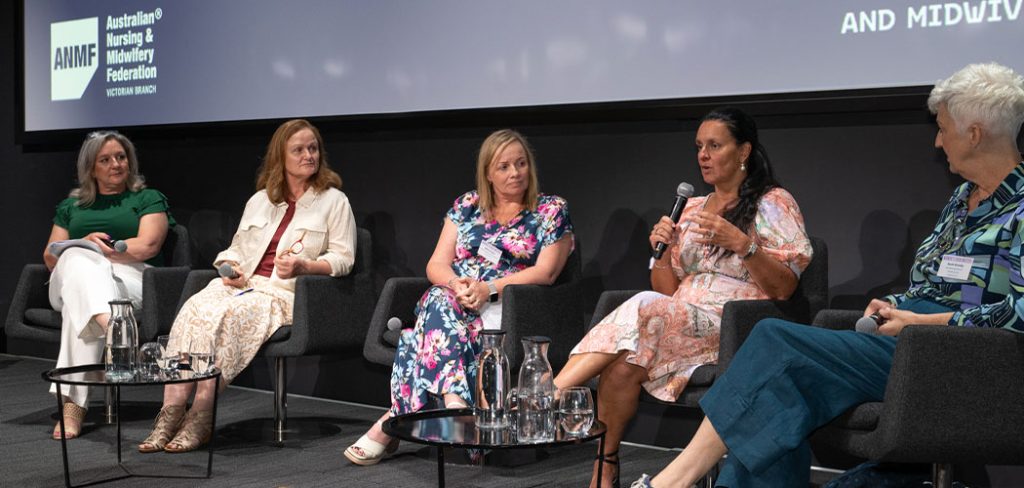Every woman has a story. From migraines to pelvic pain, aching bones and muscles to mental and hormonal health, women are living with pain that could be treatable.
But they are dismissed, their pain diminished, and they are statistically shown to have worse health outcomes than men.
The recent Victorian Inquiry into Women’s Pain and, previously, the federal End Gender Bias survey highlighted alarming trends that underscore the urgent need to rethink how healthcare systems and healthcare professionals address women and girls and their pain experiences. This was the focus of the ANMF (VIC branch) inaugural forum into women’s pain and what can be done about it, held last month.
Understanding the Scope of Women’s Pain
Revealing sobering statistics from over 13,000 responses to the Allan Government’s Victorian Inquiry into Women’s Pain, was A/Professor Dr Louise Reynolds, Chief Paramedic Officer Safer Care Victoria. Key takeaways included:
- 64% of women and girls reported living with pain scored 7-9 out of 10
- 89% experienced pain lasting over a year
- 83% said their pain negatively affected their mental health, with one in four having thoughts of self-harm
The main causes of pain for Victorian women, girls and those assigned female at birth were menstrual and hormonal, musculoskeletal and neurological. Top symptoms extended beyond pelvic pain, to include fatigue, nausea, bloating, stiffness, and migraines.
“Pain grows roots,” said Dr. Reynolds, deeply embedding itself in women’s bodies, lives, and care pathways. Despite efforts to manage their pain, women face significant barriers, including dismissal, gender bias, perceived clinical incompetence, and unaffordability of care.”
Culturally Safe and Inclusive Care
Culturally safe, trauma-informed care is essential for improving outcomes for all women, especially with the further bias that First Nations, CALD and LGBTQI+ and neuro-diverse people report in the system.
“Repeatedly we were told by participants that women from CALD communities are often called hysterical or have their pain minimised,” states the ANMF (VIC branch) Submission Inquiry into Women’s Pain
Listening to women, no matter their background or circumstances is critical to delivering better health outcomes. First-hand accounts of how healthcare workers had dismissed the pain of Victorian Aboriginal women from Jill Gallagher AO (Gunditjmara), CEO of Victorian Aboriginal Community Controlled Health Organisation (VACCHO), were powerful and unsettling.
“Nothing for us without us” said Aunty Jill, highlighting the strength of culturally safe First Nations-led care models, such as the successful breast screening program The Beautiful Shawl and the Koori Maternity Service. She also underscored the importance of Aboriginal ownership in research, aligning with another key takeaway from many other forum presenters.
Closing the Research Gender Gap
“The male body, from mouse to human, is what is studied in the lab.” (Eve: How The Female Body Drove 200 Million Years of Human Evolution by Cat Bohannon)
A critical barrier to improving care is the gender gap in medical research. With male bodies seen as “less complicated” without hormone shifts and pregnancy, male participants are dominant in all fields of medical research.
Women remain underrepresented in clinical and drug trials, anatomy education, and medical training tools. For instance, CPR mannequins are predominantly male with flat chests, limiting training effectiveness for female-specific CPR scenarios.

The ANMF (Vic Branch) Women’s Pain Matter forum, from left to right, Nicole Allan, NP Cathy Halmarick, MCH Systems Navigator Melissa Ryan, Professor Rochelle Wynne, and Endorsed Midwife Sarah Gundy. Photo: Penny Stephens
Despite cardiovascular disease being a leading cause of death for women, there is a scarcity of females represented in participation and leading cardiac research, said Professor Rochelle Wynne, Chair in Nursing at Western Health.
And it’s not only research, but also cardiac care. “It’s shown women do better when looked after by women” added Professor Wynne, “yet only 13% of cardiology specialists in Australia are female.”
Education in women’s cardiac health across healthcare and our communities has a big part to play.
The Role of Nurses and Midwives in Transforming Care
Nurse and midwife-led models of care offer promising solutions. Endorsed midwife Sarah Grundy shared her work with the Maryborough District Health Service’s Sexual and Reproductive Advice Clinic (SaRA Clinic). The clinic is run by Endorsed Midwives, providing reproductive health services to women and gender-diverse individuals in rural Victoria.
Calling endorsed midwives an “underutilised resource”, the collaborative Midwifery Group Practice model of care at SaRA exemplifies how it can address gaps in access for women in a region previously in danger of losing its maternity service.
“We don’t work in isolation. We work in collaboration. This is where the strength of healthcare lies,” Grundy stated.
Similarly, sexual health nurse practitioner Cathy Halmarick from Peninsula Health addressed a common source of trauma for women: pain during IUD insertions. Listening to one of her patients talk about how it was such a traumatic experience, NP Cathy was determined to have more in her “toolbox” to offer those in her care.
After extensive research and fighting for almost two years for approval, the clinic introduced Penthrox (commonly known as the “green whistle”) for pain relief, transforming the procedure into a more positive experience.
‘We thought we might have maybe two out of ten women requesting the green whistle for the procedure but it’s closer to seven out of ten,’ said NP Cathy, with people travelling especially to the clinic for access.
Building a better future for women’s pain care starts with recognising the barriers and solutions, addressing the need for systemic and cultural change, equitable research, and collaborative, culturally safe, trauma-informed care led by nurses and midwives. It’s time to ensure female pain is no longer dismissed but treated with the seriousness and respect it deserves.








